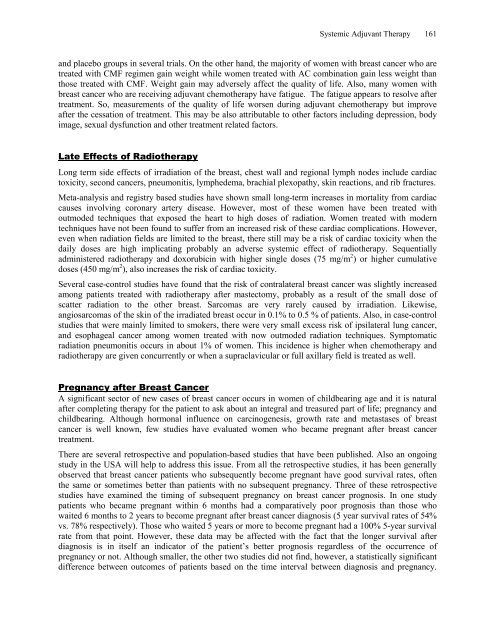Breast Cancer - Arab Medical Association Against Cancer
Breast Cancer - Arab Medical Association Against Cancer
Breast Cancer - Arab Medical Association Against Cancer
- No tags were found...
Create successful ePaper yourself
Turn your PDF publications into a flip-book with our unique Google optimized e-Paper software.
Systemic Adjuvant Therapy 161and placebo groups in several trials. On the other hand, the majority of women with breast cancer who aretreated with CMF regimen gain weight while women treated with AC combination gain less weight thanthose treated with CMF. Weight gain may adversely affect the quality of life. Also, many women withbreast cancer who are receiving adjuvant chemotherapy have fatigue. The fatigue appears to resolve aftertreatment. So, measurements of the quality of life worsen during adjuvant chemotherapy but improveafter the cessation of treatment. This may be also attributable to other factors including depression, bodyimage, sexual dysfunction and other treatment related factors.Late Effects of RadiotherapyLong term side effects of irradiation of the breast, chest wall and regional lymph nodes include cardiactoxicity, second cancers, pneumonitis, lymphedema, brachial plexopathy, skin reactions, and rib fractures.Meta-analysis and registry based studies have shown small long-term increases in mortality from cardiaccauses involving coronary artery disease. However, most of these women have been treated withoutmoded techniques that exposed the heart to high doses of radiation. Women treated with moderntechniques have not been found to suffer from an increased risk of these cardiac complications. However,even when radiation fields are limited to the breast, there still may be a risk of cardiac toxicity when thedaily doses are high implicating probably an adverse systemic effect of radiotherapy. Sequentiallyadministered radiotherapy and doxorubicin with higher single doses (75 mg/m 2 ) or higher cumulativedoses (450 mg/m 2 ), also increases the risk of cardiac toxicity.Several case-control studies have found that the risk of contralateral breast cancer was slightly increasedamong patients treated with radiotherapy after mastectomy, probably as a result of the small dose ofscatter radiation to the other breast. Sarcomas are very rarely caused by irradiation. Likewise,angiosarcomas of the skin of the irradiated breast occur in 0.1% to 0.5 % of patients. Also, in case-controlstudies that were mainly limited to smokers, there were very small excess risk of ipsilateral lung cancer,and esophageal cancer among women treated with now outmoded radiation techniques. Symptomaticradiation pneumonitis occurs in about 1% of women. This incidence is higher when chemotherapy andradiotherapy are given concurrently or when a supraclavicular or full axillary field is treated as well.Pregnancy after <strong>Breast</strong> <strong>Cancer</strong>A significant sector of new cases of breast cancer occurs in women of childbearing age and it is naturalafter completing therapy for the patient to ask about an integral and treasured part of life; pregnancy andchildbearing. Although hormonal influence on carcinogenesis, growth rate and metastases of breastcancer is well known, few studies have evaluated women who became pregnant after breast cancertreatment.There are several retrospective and population-based studies that have been published. Also an ongoingstudy in the USA will help to address this issue. From all the retrospective studies, it has been generallyobserved that breast cancer patients who subsequently become pregnant have good survival rates, oftenthe same or sometimes better than patients with no subsequent pregnancy. Three of these retrospectivestudies have examined the timing of subsequent pregnancy on breast cancer prognosis. In one studypatients who became pregnant within 6 months had a comparatively poor prognosis than those whowaited 6 months to 2 years to become pregnant after breast cancer diagnosis (5 year survival rates of 54%vs. 78% respectively). Those who waited 5 years or more to become pregnant had a 100% 5-year survivalrate from that point. However, these data may be affected with the fact that the longer survival afterdiagnosis is in itself an indicator of the patient’s better prognosis regardless of the occurrence ofpregnancy or not. Although smaller, the other two studies did not find, however, a statistically significantdifference between outcomes of patients based on the time interval between diagnosis and pregnancy.









